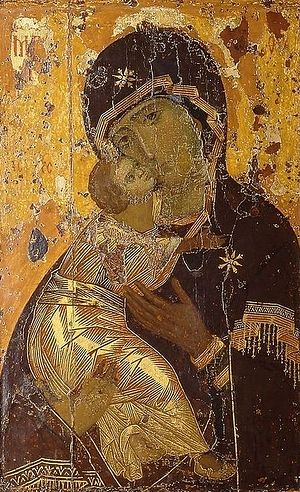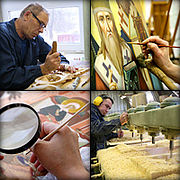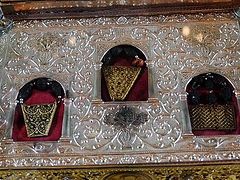No spiritual activity permeates Orthodoxy as much as veneration. For the non-Orthodox, veneration is often mistaken for worship. We kiss icons; sing hymns to saints; cry out “Most Holy Theotokos, save us!” And all of this scandalizes the non-Orthodox who think we have fallen into some backwater of paganized Christianity. It is not unusual to hear Orthodox who more or less apologize for this activity and seek to minimize it. “We are only trying to give honor to the saints, etc.” What is lacking, all too often, is a vigorous explanation for the work of veneration and its central place in the Christian life.
The normal mode of “seeing” in our daily world can be called “objective.” We see things as objects, and nothing more. Indeed, we see most people as objects unless we have reason to do otherwise. Sometimes we see people as objects in order not to see them as otherwise. But this objective viewing is an extremely limited and limiting way of seeing anything. Veneration brings us to a different form of seeing.
It is carefully noted in the accounts of Christ’s resurrection that he is unrecognized at first, and on more than one occasion. Mary Magdalen mistakes Him for the gardener. The disciples on the road to Emmaus talk with Him while they are walking but do not recognize Him until the moment at which He disappears. The disciples who are fishing do not recognize Him until after they have a miraculous catch of fish.
The silliest explanations of these failures to recognize are the ones that try to attribute it to grief. The stories clearly have something else in mind. That something else is particularly revealed in Christ’s encounter with Mary Magdalen. She thinks He is the gardener and wants to know where the body of Jesus has been moved to. But suddenly this “gardener” calls her by name, “Mary.” And she recognizes Him.
What has taken place is the change from an objective seeing to a personal seeing. It is only in the realm of personhood that we experience communion. We do not commune with “mere” objects. The Resurrection, among many things, represents the triumph of the personal over the objective/material. The Resurrected Christ cannot be seen in an objective manner, or, at least, He cannot be seen for who He is in such a manner. It would be more accurate, or helpful, to say that He is discerned, or perceived, rather than merely seen. Both “discerned” and “perceived” imply something more from the observer than simple seeing.
Veneration is far more than the acts of bowing, kissing, crossing oneself, offering incense or lighting candles. Those things become veneration when they are offered towards the person who is made present in an icon. An icon that becomes an object ceases to be a true icon and becomes mere art, or worse, the object of a fetish. The Fathers taught that an “icon makes present that which it represents.” The veneration of an icon is an encounter with a person.
It is worth noting that in the canonical painting of an icon, persons are not portrayed in profile (other than the devil and Judas). We always encounter them face-to-face. The impersonal, objective treatment of another person is an act of shaming and inherently hides our own face from them.
At some point, the Church’s use of iconography became distorted and became the Church’s use of art. Art is interesting and serves the end of beauty (when done well). But this development in the Church (primarily in the West, but then occasionally in the East as well, as certain styles were copied) represents a turning away from the icon as encounter and the objectification of human beings and nature. It is among the many serious steps that created the notion of a secularized world.
Jesus, as an artistic subject, is equally accessible to all. His use in art renders Him as object. Indeed, Jesus is frequently used to “make a statement.” But this is the anti-icon, the betrayal of the personal as made known to us in the Resurrection. Christ becomes historicized, just one object among many to be dissected and discussed.
Of course, Christians are free. We may decorate our lives with art as we choose so long as we don’t confuse art with iconography, nor religious sentiment with spiritual encounter. But our engagement with art can easily overtake our experience of icons. Our culture knows how to “see” art, but icons remain opaque. Only the true act of veneration reveals what is made present in an icon.
I can recall my first experience with an icon. I had bought a print from St. Vladimir’s and mounted it. I would have it in front of me during my prayer time. I would look and think, and look harder. I think I expected to “see” something or for there to be a trail of thoughts inspired by my looking. But it was simply empty. I was a young college-age Anglican at the time and had no idea how to find my way into the world of an icon.
Some decades later, I became Orthodox, having written a Master’s thesis on the theology of icons and come to understand them. The summer following my conversion, I visited St. Vladimir’s Seminary for my first time. I was surprised when I walked into the chapel to see that the icon of the Virgin on the iconostasis was the original of the small print I had begun my journey with. And then I could see her. All of the journey seemed intensely personal, without accident or caprice. She had brought me home!
This is something that veneration begins to reveal to us. We do not think about the saints or imagine them. In their icons and our veneration, we come to know them. We see them face to face and even learn to recognize them and their work and prayers in our daily lives. The world is not accident and caprice. It is deeply intentional and personal, and conspiring towards our salvation.
The “objects” in our lives are nothing of the sort. It is only the dark and callous objectivity of the modern heart that has so disenchanted reality. We imagine ourselves the only sentient beings marooned on a small, blue planet in space. We wonder if there is “life” out there, as if there were anything else anywhere.
The world is icon and sacrament. But it cannot be known until we see it face to face. Listen to these sweet words from St. John of Damascus (7th century):
I honor all matter, and venerate it. Through it, filled, as it were, with a divine power and grace, my salvation has come to me. Was the three-times happy and blessed wood of the Cross not matter? Was the sacred and holy mountain of Calvary not matter? What of the life-giving rock, the Holy Tomb, the source of our resurrection — was it not matter? Is the holy book of the Gospels not matter? Is the blessed table which gives us the Bread of Life not matter? Are the gold and silver, out of which crosses and altar-plate and chalices are made not matter? And before all these things, is not the body and blood of our Lord matter? Either stop venerating all these things, or submit to the tradition of the Church in the venerating of images, honoring God and his friends, and following in this the grace of the Holy Spirit. Do not despise matter, for it is not despicable. Nothing that God has made is. Only that which does not come from God is despicable — our own invention, the spontaneous decision to disregard the law of human nature, i.e., sin.




